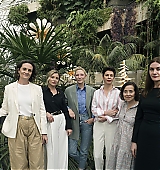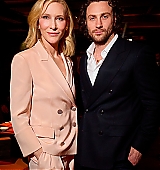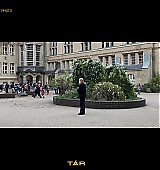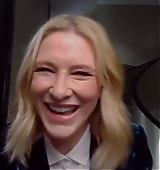As Cate Blanchett celebrates her birthday today, we wish her all the best!
On one of our favourite days of the year, here is our annual gallery update. We have added photos and updated some low quality to middle/high quality photos from events, movies, photoshoots, magazine scans, and other works.
Some documentaries and TV specials these past years where Cate appeared have been made available below.
On Saturday, 18 May, RUMOURS will have its world premiere at Cannes Film Festival. The VR project EVOLVER where Cate is the narrator is competing at the Immersive section of the festival.
The site is run for free however every year we have to pay the renewal cost and the deadline is in August. We hope that you can support the site by donating — we highly appreciate any amount. You can click on the donate button below or on the left side bar (when viewed on desktop).
We hope you enjoy the update!

or by using the QR code

























































































Io Donna Interview
The statement “Yes” is a professional motto with Giorgio Armani. What other values does it have?
CB: “Yes” for me is an affirmation of life. Trying to say “yes” in difficult times seems to me as relevant and important as ever.
tante. “Yes” is to think that life is not only about existing, but also about exposing yourself and fighting for your ideas, predisposing yourself to experiences and changes. Sometimes saying yes is the best choice we can make. For me, saying “Yes” to Giorgio Armani many years ago was one of the best decisions in life because it gave me the gift of friendship with an incredible man. He taught me that many things are possible by remaining open to the world.After Cannes, in the summer we will see her in Borderlands, a film in which she plays an orange-haired, leather-suited heroine who tries to save a dystopian world, another metaphor for current times. What was it like playing her?
CB: A real madness, in the most positive sense of the word! When I heard that Jamie Lee Curtis, by far one of the women I most admire, would be in the cast, I said, “No matter what it is, I have to be there!” The beauty of the film was the group of people who worked on it, from Kevin Hart and Jack Black: between stunt scenes and jokes, we all went back to being kids a little bit.So you had a good time. What amuses you?
CB: I actually have fun almost all the time, whether on set or directing, no matter how intense the role or the story I have to tell. I love my work because it “expands” who I am. I enjoy stepping into roles and looks that I would never dare in life. For example, neon carrot hair!Full interview on Io Donna
Cahiers du Cinéma Interview
You can grab your own copy on Cahiers du Cinéma’s site here or at Newsstand (Mai 2024 – n°809 issue with Cate won’t be available on the site until 14 May) here.
You’re able to combine the allure of stars found in film after film, as in classic cinema, with a taste for masks, disguises and costumes, as when you played Bob Dylan in I’m Not There (Todd Haynes, 2007) or a multitude of very different characters in Manifesto (Julian Rosefeldt, 2015).
CB: I’m Not There and Manifesto were two very strong and liberating experiences in this sense. Already by the unusual aspect of the proposition, which always attracts me, but rarely happens. Probably because people don’t know what to do with me, maybe because I don’t know myself. It’s a human problem, not just a game problem. But I also don’t have enough time to do them. I had to shoot Bob Dylan right after Elizabeth: The Golden Age (Shekhar Kapur, 2007), for which I had to lose a lot of weight. So I lost more and more weight throughout the filming. I had to shoot Bob Dylan right after Elizabeth: The Golden Age (Shekhar Kapur, 2007), for which I had to lose a lot of weight. So I lost more and more weight throughout the filming. During lunch breaks, I obsessively watched the footage of Dylan filmed by Pennebaker in Don’t Look Back, while playing Elizabeth I. I finished on a Friday, and that same evening I took a flight to Montreal with my children, to shoot there on Monday with Todd Haynes. So the transformation you are talking about happened without being able to think too much about it. It’s wildly liberating to do that. Manifesto was shot in eight days. We had prepared the overall architecture, chosen the staging corresponding to each persona and each manifesto. I was able to establish a special relationship with Bina Daigeler, the costume designer, whom I recently met again in Tár. These positions, costumes, make-up, predominantly female departments, are fundamental in the way I conceive films. The conversations we can have with the people who occupy them during rehearsals are often decisive. There’s a huge amount of preparation for these roles, including mental preparation. But the moment of doing it is always terrifying. It’s close to stand-up, because you have to invent everything, it’s very theatrical, which I like a lot.Theater always comes up in your words, and it’s not surprising: very often in your films, we have the impression that you manage to create your own form of temporality, a somewhat separate present in the unfolding of the film.
CB: What you say is extremely flattering, I’m interested! We come back to time. Todd Field has a beat, I can’t remember, I think it’s 160 bpm. He called it “the march of Tár”, it was the second movement of Górecki’s String Quartet No. 2, whose rhythm I had to follow when I walked, while Sophie Kauer had to have a different rhythm. Rhythm allows you to find the pulse of a character. And maybe it’s something that comes from my theatrical training: even when the text is dispensable or banal, I’m constantly drawing on it to find a rhythm. As humans, that’s how we function: we find a rhythmic meaning to life, more than an intellectual one. There’s that old idea that you don’t need technique to play, except when something goes wrong, in which case you have to restart the engine. If it flows naturally, there’s a kind of obviousness, but you always have to find those moments of stumbling; that’s what dramaturgy is all about. Someone who stumbles and tries to catch up, to find their rhythm, counterpoint. It is in these moments that we can see who a person really is, in a way that they themselves may be unable to see. Since childhood, everyone learns in a different way, and I think my learning is kinetic. Even when I have long monologues on stage, I have to move, I’m unable to learn my lines until I’ve situated them in space, worked out my place in relation to the other characters and the audience. Then, for complex characters like Lydia Tár or Katharine Hepburn (in Martin Scorsese’s Aviator, 2004, editor’s note), you can ask yourself why she says a particular sentence, is it really what she thinks or its opposite.Do you like to initiate projects? Taking the first step towards producers, filmmakers, scriptwriters…
CB: In the past, actresses had to do their own research, more so than actors, because they weren’t offered roles that were complex or interesting enough. It was common then for an actress to buy the rights to a book and become the driving force behind a film adaptation. I never wanted to do that, simply because I don’t like reading novels to “play” them. And because one of my favorite feelings is when a filmmaker or producer approaches me to offer me a project that I would never have thought of. I feel that when I force something into existence myself, my work loses its naturalness. As a producer, I like to do this for others, to suggest that such and such a screenwriter collaborate with such and such a filmmaker or actress, when I know that this can result in something beautiful. But as an actress, I feel more like a walking comedian, and my choices are partly subject to chance. Perhaps that’s why I’m more eclectic, including a lot of missteps and things that didn’t work out. I know there are many films I could have made but had to give up for family or personal reasons. But I’ve learned to love chance.When did you know you wanted to be an actress?
CB: It never really occurred to me as a profession… In fact, I’m still waiting for my real life to begin! Logically, I’d have to say it was when I entered the drama department at university, but even when I graduated, the film industry in Australia was so small that working in theater already seemed like a joy, I never imagined a career in film. I never felt I was “the one”. Things have changed a lot for women since I first stepped into the murky waters of this industry. And the change continues, which is very exciting. This will make you laugh, but I still don’t feel like an actress. Sometimes I’m on the red carpet, and I think, “How the hell did I get here?” It took me by surprise. And maybe that’s why I have a relatively healthy relationship with this world, in my opinion. Because I’ve never expected it to give me more than it can.And what is it that makes a collaboration with a filmmaker extend over several films, as with Soderbergh, Haynes or Malick, for example?
CB: In the case of Terrence Malick, with whom I worked three times, it’s also due to the rapid succession of his films. He was used to making one film per decade, and at some point he became obsessed with lost time and the time he had left, and wanted to work a lot. During the shooting of Knight of Cups (2015), he mentioned the possibility of me doing the voice-over for a documentary he’d been working on for years, Voyage of Time (2016). I have the impression that sometimes things happen alongside what we’re working on, in parallel, as if we were playing hooky from school. Finding Jim Jarmusch twenty years after Coffee and Cigarettes for his next film, Father, Mother, Sister, Brother, was very beautiful for me. Because at the time, he immediately asked me to work with him again, and I had to give up: the children, living in Australia, it was impossible. I had to wait years to make up for this sad lack, to meet him again in New York, to be able to integrate what he was doing and to feel that time had not passed. Another reason why I didn’t work with Wes Anderson again after The Life Aquatic (2004), it’s also for reasons like these, but we could meet up again one day. I don’t believe in regrets. Maybe I’m not Catholic enough for that. Especially because, in the end, the films we give up on end up being made in the right way, with the right people.






 A Manual for Cleaning Women (202?)
A Manual for Cleaning Women (202?) Father Mother Brother Sister (2025)
Father Mother Brother Sister (2025)  Black Bag (2025)
Black Bag (2025)  The Seagull (2025)
The Seagull (2025) Bozo Over Roses (2025)
Bozo Over Roses (2025) Disclaimer (2024)
Disclaimer (2024)  Rumours (2024)
Rumours (2024)  Borderlands (2024)
Borderlands (2024)  The New Boy (2023)
The New Boy (2023) 












Meudeus, eu amo tanto a minha menina!!! Feliz aniversário, minha razão de viver. Amo-te demais, amor meu.
Você é a experiência de um sentimento tão profundo & intenso que não pode ser adequadamente expresso em palavras. Amar você é inefável, Elise.
180 mil palavras únicas e 576 mil definições; Nenhuma delas conseguiriam descrever o meu amor pela Cate. ??????????
Oh my god, I love my girl so much!!! Happy birthday, my reason for living. I love you so much, my love. You are an experience of a feeling so deep and intense that it cannot be expressed in words. Loving you is ineffable, Elise.
180 thousand unique words and 576 thousand definitions; None of them could describe my love for Cate. ????????.
Oh my god, I love my girl so much!!! Happy birthday, my reason for living. I love you so much, my love. You are an experience of a feeling so deep and intense that it cannot be expressed in words. Loving you is ineffable, Elise.
180 thousand unique words and 576 thousand definitions; None of them could describe my love for Cate. ????????.
tell Cate that I love her ?????? (I’m from Brazil lol)
tell Cate that I love her ?????? (I’m from Brazil lol)